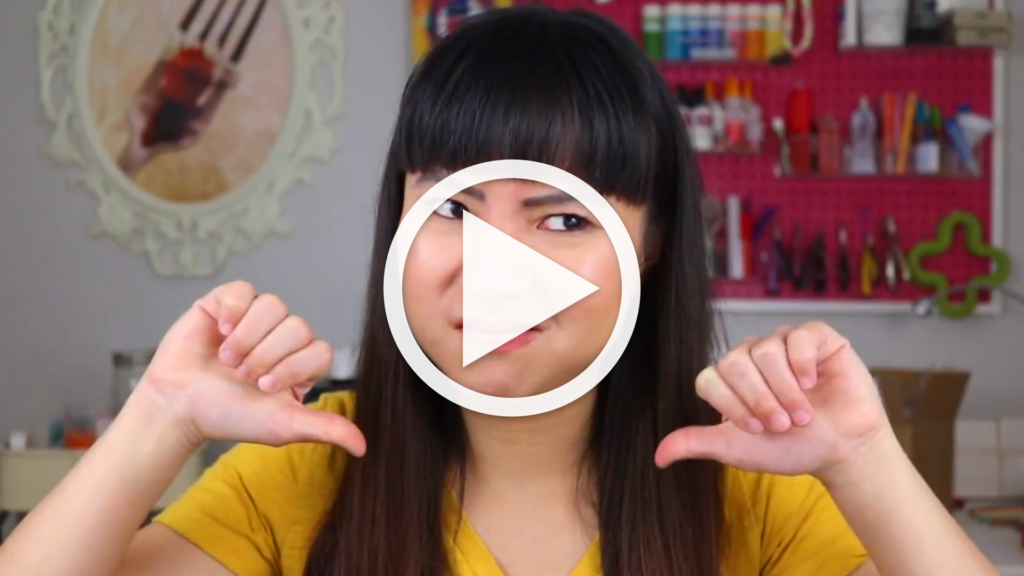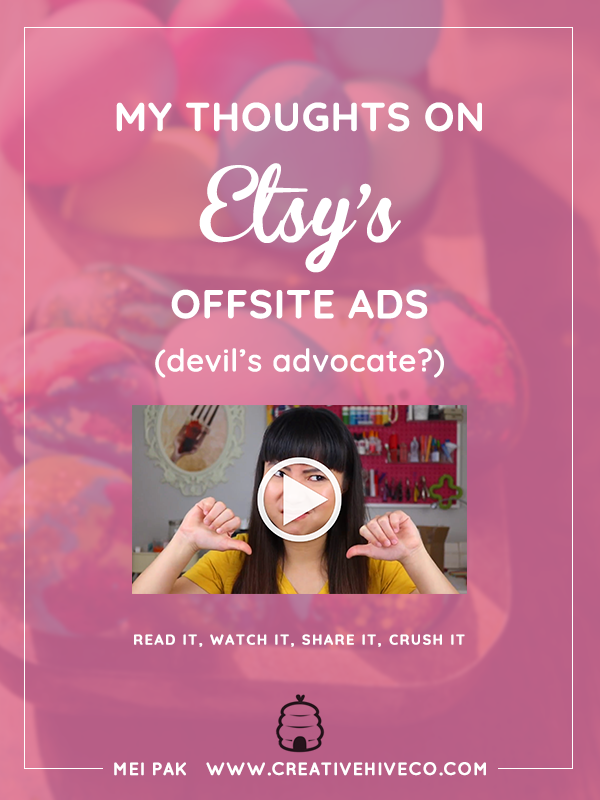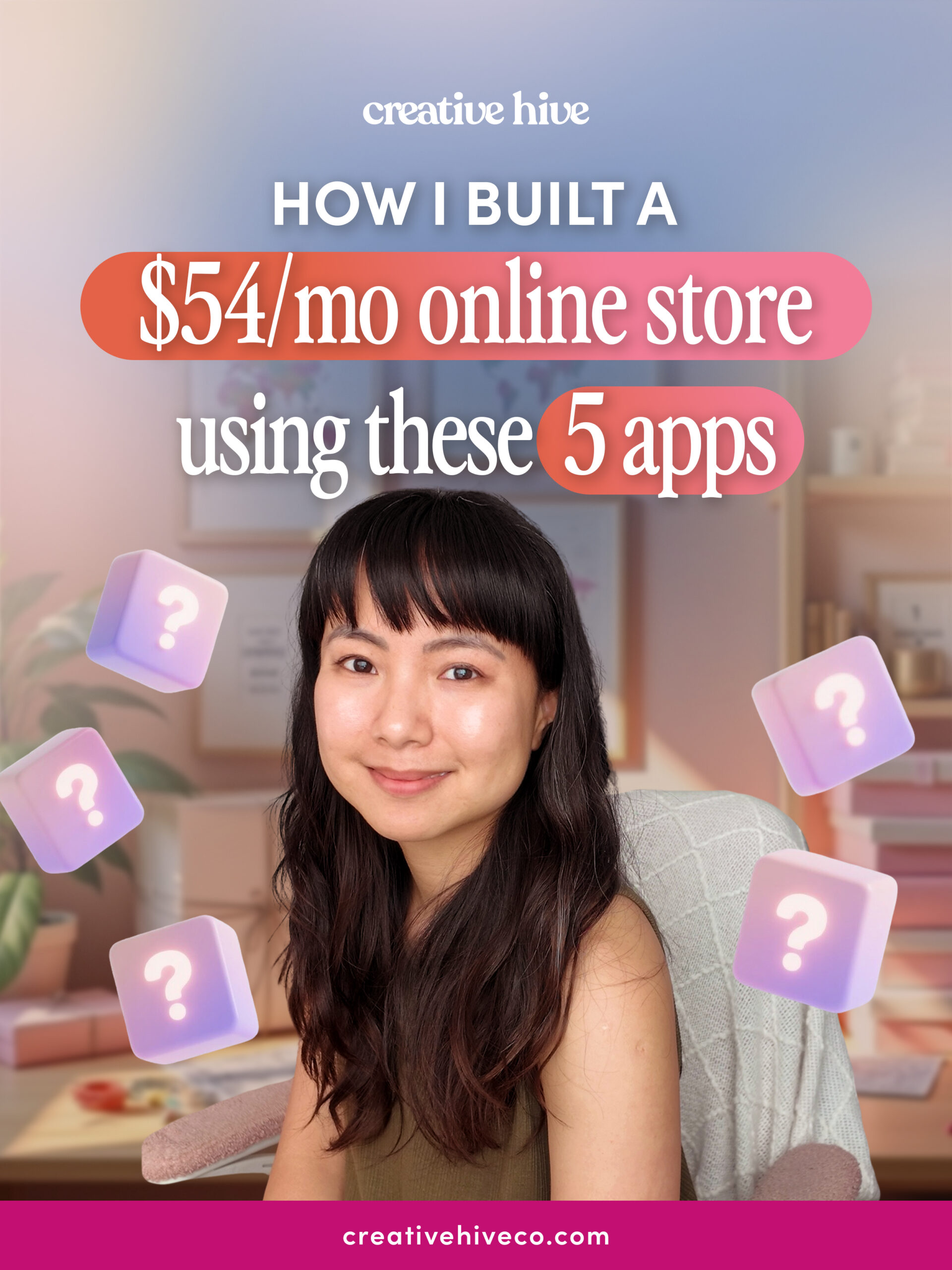I want to help you build a sustainable, profitable handmade business that makes you consistent income and sales. I only ever teach or recommend marketing, social media, pricing, production and branding tips that I’ve personally used successfully in my own 7-figure handmade businesses.
I'm Mei, from Los Angeles!
Read More
Popular Posts You'll Love
Looking for something?
Categories
starting a business
get more traffic
running a business
make more sales
branding
growing a business
mindset & productivity
podcasts
pricing & money
product photography
reviews
selling on etsy
selling on amazon
social media
selling wholesale
- Facebook0
- Twitter7
- Pinterest10
- 17shares
Etsy’s new offsite ad policy has made a lot of sellers upset. In this post, I’ll be taking a look at what these changes might mean for you and exploring whether selling on Etsy is still worthwhile, or if it’s time to start selling elsewhere.
What are Etsy Offsite Ads?
First, let me explain at a high-level overview, what Etsy offsite ads are.
Etsy recently announced upcoming changes to its policy regarding offsite ads. One of the major benefits of selling on Etsy is that your store is advertised to a wide audience. As well as visitors to the actual Etsy site, your products are showcased to potential buyers through offsite ads on sites like Google, Facebook, Instagram, Pinterest & Bing. And Etsy expects at least 1 in 10 leads to come from these ads.
This feature has been available to all sellers for free… until now.
In Etsy’s own words,
“Until May 1, 2020, you won’t be charged a fee for any orders that result from Offsite Ads. If you make a sale from a click on one of Etsy’s Offsite Ads after May 1, you’ll pay an advertising fee for that order.”
But just how bad will these fees be?
For some sellers, the fees will be mandatory. For others, they’ll have the choice to opt-in and pay the additional fees, or opt-out and risk missing out on offsite advertising and potential income.
It all depends on how much you earn from sales in a 12 month period. If you sold over $10,000 in sales on Etsy in the past year, based on the item price only, you will automatically be enrolled in offsite advertising.
You cannot opt-out if you are over the 10k threshold but instead, you pay a lower percentage of fees compared to those who choose to opt-in.
In other words, top earners will be forced to pay a 12% fee on the total order amount of any sale that was generated from an offsite ad. The fee will apply to shipping costs, shipping upgrades, gift wrapping and taxes charged by non-US & non-Canadian shops.
Therefore, this is a bigger fee hike for anyone with expensive shipping costs and for sellers based outside of North America, such as European sellers.
The fee will be capped at $100 per sale. Is that supposed to be comforting?
Those who sell less than $10,000 in 12 months but opt-in to the new offsite ad terms, will be charged 15% on the sales offsite ads bring you.
Not to mention, all sales made from an offsite ad in the 30 days after a customer clicked it will be subject to the 12%-15% fees.
So, that means, if a shopper clicks an ad and purchases from your shop multiple times, even in separate orders, within the 30-day window, you’ll have to pay an offsite ad fee for each of those orders.
Under what circumstances will the fee not apply?
If you had to refund an order, you’ll get your fee back. The fee will also not apply if the buyer clicked on an ad featuring another shop but then came to your shop and made a purchase.
How are people reacting to this new policy?
Inevitably, sellers will either have to absorb the loss or they’ll probably compensate by raising their prices.
Obviously, a lot of long-term sellers are upset about this, especially since the fees are pretty high and seemingly is coming out of nowhere.
Add that to the fact that Etsy already charges a 5% shipping and transaction fee, plus a 3-4% fee for Etsy Payments. In total, you could lose up to 24% of your income from a sale, even before considering other costs such as listing fees.
Here’s an example of the offsite fee in action.
Say you sold an item on Etsy for $45 with a $5 shipping cost, that gives you a total price of $50. You have to pay a 20 cents listing fee for your item, a transaction fee of $2.25 (which is 5% of the item price), 25 cents in shipping fees (that’s 5% of your shipping cost), a total payment processing fee of $1.50, then comes the new $6.00 offsite ad fee (based on the lower 12% fee for more experienced sellers). That a total of $10.45 in fees. That leaves you with a profit of $39.55 before deducting shipping, materials and supplies, labor and overhead.
The total fees you pay Etsy are almost 21% of the sale.

To put things into context, let’s compare this to Amazon and Amazon Handmade. First, there is a listing fee of $0.99 for individual sellers or a $39.99 monthly fee for professional sellers. Second, depending on the type of item you sell on Amazon, a referral fee of between 8% and 20% of the total price, including shipping, is charged.
If you’re on Amazon Handmade, it’s a flat fee of 15%.
So if we use the same example as before for $50 item, including shipping, we minus an average listing fee of $0.99 and an average 15% referral fee of $7.50, you’re left with a profit of $41.51.
That’s around a 17% fee to sell on Amazon. That’s 4% lower than Etsy, which means 4% more money to you.
Bear in mind though, when selling on Amazon there may be other fees depending on the payment method, Paypal fees for example, and the fees are much more variable depending on what you’re selling.
Here’s the kicker – Amazon has a bigger customer base and less competition compared to Etsy. So it might be a good move to set up shop on Amazon.
I think what makes this really hard to swallow is that we’ve all learned to expect a certain fee percentage to sell on Etsy, so when that fee goes up, people are upset. Even though this new fee is now more aligned with the true costs for making sales online anywhere else, like on Amazon or your own site or if you sell wholesale or consignment.
It’s also awful that you don’t have a choice.
Even when you think you have a choice for selling less than $10,000, it won’t feel like a choice because you know Etsy will not promote your shop items as much if you don’t participate.
For the smaller percentage of Etsy sellers who have too many orders and they can’t keep up, obviously this policy is going to hurt more than help them. But there’s really nothing you can do about it, and that’s the danger of giving someone else control over your business. You have to play by their rules.
Why is Etsy Doing This?
So why is Etsy doing this? They’re taking a big risk with introducing the fees, as I’m sure they know that this will cause many sellers to leave the platform.
My theory, is that by enforcing the mandatory fees at the $10,000 sales mark, they’re targeting sellers who are less likely to quit or move because they’re so dependent on the platform and their existing customer base. Essentially, Etsy is taxing the successful sellers because they know they can.
You may be tempted to think that Etsy is just being greedy. Multiple Etsy support staff have also reportedly confirmed that they are not planning on buying additional Google, Facebook or Bing ads, at least no more than they already do.
To be fair to them, they were previously buying the offsite advertising for shops and they’re the ones incurring the cost to do so, not the shop owners.
They are a business and at the end of the day, they have to make money and be profitable to be able to provide a service.
And all of this to me, is Etsy just trying to keep up with rising costs.
There is more competition now than ever, not just on Etsy but everywhere online, which means getting the attention of buyers is becoming more expensive. And that’s a cost that you now have to bear.

The Pros and Cons to this Etsy Update
So, what are the pros and cons to this Etsy update?
Pro: Risk-Free Advertising
For one, consider that this is risk-free advertising because there’s no upfront cost. You only pay once you’ve made a sale.
To put this into perspective, doing ads on your own is not easy. It’s a steep learning curve and a lot of people lose money doing it. And if you hired help for it, anticipate it to cost at least $1500 per MONTH in just service fees, not counting actual ad spend.
With Offsite Ads, you’ll be passing all the work to Etsy without having to pay if there’s no sale and you don’t have to learn how to do ads.
Doesn’t sound so bad, right?
Pro: Control Over Your Advertising Investment
Also, can I just focus a bit more on the certain control you have now with your advertising investment? For those who’ve had shops on Etsy, Google ads are much more expensive than those ads on Etsy’s site itself.
Thing is, we’re not allowed to exclude it or opt out when paying for ads. With this Etsy update, these two don’t have to come hand in hand.
Google ads is now part of the list of offsite platforms. That means you can choose to advertise your products within Etsy only and exclude Google altogether if you want.
Pro: Incidental Traffic
Now, what if someone clicks on an ad featuring another seller’s items yet they happen to explore a bit more and end up in your shop? And what if you make a sale from it?
Short answer, you don’t pay for any advertising fee!
This is the beauty of offsite ads. Sometimes, it can create “incidental traffic” on your shop and you get exposure for free!
Which brings me to the next advantage of this update.
Pro: Etsy’s Advertising Budget will Increase
We should anticipate more money going into Etsy’s advertising budget, because now they’re taxing you for it.
Having more money will most likely result in much more traffic to Etsy in general. That means Etsy, as a whole, will get more visitors.
If you zoom out a bit further on this situation and see the bigger picture, this is definitely a win for the entire community!
But, of course, this update comes with a number of disadvantages too. Some really icky ones.
Con: You Can’t Opt-Out if You’re Above the $10K Mark
The first is what I think many people are upset about. If you’re doing relatively well on Etsy, and you’re selling more than $10,000 in the last 12 months, participating in Offsite Ads is mandatory.
You simply can’t opt-out. You have no choice.
Con: Once You’re in the $10K Margin, You’re In for Life
Second, once you’re in the $10k margin, you’re going to be in there forever regardless of whether you earn as much or less than 10,000 next year!
WHAT?!
Con: Unfair Attribution of Sales
What do I mean by this? Well, let’s say we have a buyer who recognizes and remembers the name of your shop. There’s a specific product she wants to buy from you. She opens up a browser, types the name of your shop in and she will be shown a list of search results. That will include an Etsy ad.
She unknowingly clicks on that ad, not knowing it was an ad, finds your product, and buys it.
What really happened here? Well, you have a customer who knows your shop name and doesn’t need an ad to buy from you. Yet, because Etsy decided to position the ad “strategically”, you now have to pay for the 12% or 15%!
Also, imagine this: a repeat customer is scrolling on, say, Instagram, and saw an ad of your product. And then clicked on it just to visit or check if you’re selling anything new but didn’t buy anything at all.
Sounds harmless.
But what if that same person visits your shop again within the 30 days window to buy something they’ve actually been meaning to buy? Or, because they’re your Instagram follower, they saw your own organic posts promoting your product.
You’re still charged with the ad fee regardless even though it was your Instagram marketing efforts that prompted them to buy.
Personally, my store has already seen a dramatic increase in the percentage of fees compared to the last year.
Between January and March 2019, my fees paid to Etsy totaled 7.5%. That’s really low.
Over the same period this year in 2020, I have paid 34.3% of my sales in fees to Etsy. Keep in mind that this is before the new Offsite Ads have been introduced!
Is it Time to Jump Ship?
So, is it time to jump ship? What are the Etsy alternatives?
I’ve touched on this topic in recent videos, feel free to check these out.
Before you make any knee jerk reactions, it’s important you have perspective on what it’s like selling online besides Etsy.
One mistake that people make too often is believing that their customer base can easily transfer or be matched elsewhere.
Remember though, part of why Etsy is introducing these new fees is because they do the work in advertising for you, and they already have an established, popular brand with a built-in audience.
Etsy is a marketplace and there are others like it.
For example, Amazon, but they too have listing fees, transaction fees of up to 15% and shipping fees. So you may not even be better off by switching, or be marginally better off at best and risk losing regular customers who bought from you on Etsy.
My recommendation, as I’ve preached over and over again, is to keep your Etsy shop active while you work on building up a customer base elsewhere.
You can branch out while still making some sales on Etsy, even if you suffer a small drop in profits in the meantime. A sale is still a sale.

Gaining Some Perspective
While there’s no doubt that their increase in fees is appalling, we need some perspective.
I’ve been selling primarily on my own site for the last 14 years and now I own multiple online shops and businesses.
It costs money to make sales online and that cost is only increasing if you don’t keep up with how to do marketing on your own.
I know what it’s like to be out here in the wild, wild west.
If I had to pay 20%-30% of my sales to someone else as a commission for helping me make that sale, that’s a really reasonable price. So while Etsy’s new fees sound high, it’s actually now more aligned with the rest of the online space.
And this is not just for my own shop.
If you talked to service providers, agencies or marketers who help shop owners make sales, they’re actually proud if they can make their clients 2-3x a return on their investment. That’s considered good! I share this with you to show you that this is just the benchmark cost to make a sale online, across the board, and I think Etsy, up till now, has been spoiling us.
Consider also that with Etsy’s offsite ads, you don’t have to pay anything until you make a sale.
This is essentially a performance-based advertising plan. If you did ads yourself, you have to pay money even when you didn’t make sales. Not to mention, the amount of time and money you’d have to invest in learning how to do paid ads well, to begin with.
It’s not easy and most people fail and lose a lot of money.
Bottom line is, as long as your products are priced correctly, you can still make a healthy profit under the new offsite ad fees. I have a pricing formula video that you can watch.
My ultimate suggestion would be to use Etsy as a form of ‘semi-passive income’.
Stop focusing so much on Etsy and the effort you were once spending on it can be redirected toward creating your own store on your own platform.
You may have to work harder to build up your traffic at first, but think of it as a long term, more reliable strategy.
What do you think? Do you feel that Etsy’s new ad policy is too much? Or do you see it more as a convenience fee that’s justifiable for the services they offer? Let me know in the comments.

Leave a Comment
Liked this article? Share it!
Unlock a Profitable Handmade Business
in Just 12 Weeks Without Using Etsy
or Social Media
FREE WORKSHOP
This workshop is for anyone who makes and sells a handmade or physical product, including jewelry designers, artists, paper designers, bath & body product makers and more!
What You'll Discover
The #1 mistake people make with Etsy & social media that causes shops to FLOP
The secret to making it with your handmade shop so it's no longer just a hobby
How to make sales in your handmade shop with ease so you can finally get to 6-figures
TAKE ME THERE
Leave a Reply Cancel reply
About
Blog
A Sale A Day
Student Login
Free Class
Contact
Terms
Become A Student
Watch On YouTube
Student Reviews
See My Handmade Shop!



Your email address will not be published. Required fields are marked *